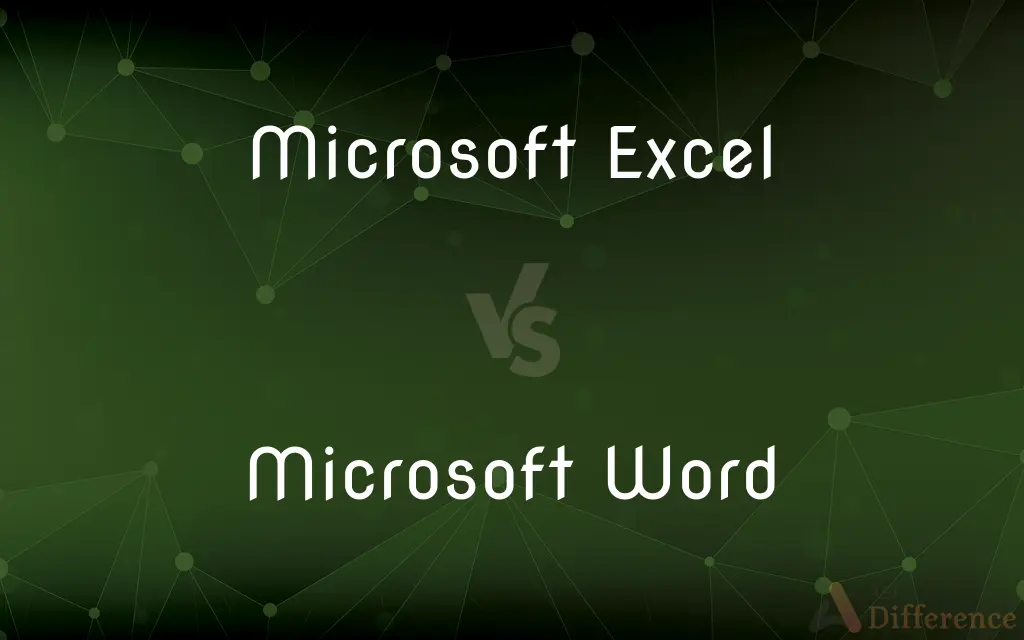Microsoft Excel vs. Microsoft Word — What's the Difference?
By Tayyaba Rehman — Published on January 26, 2024
Microsoft Excel is a spreadsheet application for data organization, analysis, and visualization, while Microsoft Word is a word processing application for creating and editing text documents.

Difference Between Microsoft Excel and Microsoft Word
Table of Contents
ADVERTISEMENT
Key Differences
Microsoft Excel is designed for managing and analyzing data using spreadsheets, ideal for numerical and statistical calculations. Microsoft Word, on the other hand, is primarily used for creating text-based documents like reports, letters, and essays.
Excel offers features like formulas, functions, pivot tables, and graphing tools for complex data analysis and visualization. Word focuses on text formatting, page layout, and document design, providing tools like font customization, templates, and styles.
Excel is essential for tasks involving large datasets, budgeting, and financial forecasting, allowing users to manipulate and present data effectively. Word is better suited for writing and editing text, making it ideal for drafting documents, manuscripts, and resumes.
In Excel, the primary unit is the cell, where data is entered and manipulated in a grid format. In Word, the focus is on paragraphs and pages, with an emphasis on text flow and readability.
Excel supports complex mathematical operations and statistical analysis, offering extensive data processing capabilities. Word, while it can handle basic tables and calculations, is more focused on text editing and formatting.
ADVERTISEMENT
Comparison Chart
Primary Use
Data management and analysis
Text document creation and editing
Key Features
Formulas, pivot tables, graphs
Text formatting, templates, styles
Ideal For
Numerical data, budgets, forecasting
Reports, letters, essays, manuscripts
Basic Unit
Cell in a spreadsheet
Paragraph in a document
Functionality
Complex calculations, data visualization
Writing, editing, document layout
Compare with Definitions
Microsoft Excel
Ideal for managing large datasets and creating pivot tables.
I organized our customer data in Excel using a pivot table.
Microsoft Word
Offers extensive text formatting and page layout options.
I used Word to design a professional-looking resume.
Microsoft Excel
Supports automation through macros and scripting.
I automated our monthly reporting process in Excel with macros.
Microsoft Word
Includes features like spell check, track changes, and comments.
Editing the manuscript in Word was easy with track changes.
Microsoft Excel
Features tools for complex calculations and statistical analysis.
Calculating the company's financial ratios was easy with Excel.
Microsoft Word
Often used for creating templates and personalized documents.
I created a newsletter template in Microsoft Word.
Microsoft Excel
Often used for budgeting and financial forecasting.
Our annual budget forecast was prepared using Excel.
Microsoft Word
Suitable for writing essays, reports, and letters.
I wrote a detailed project report in Word.
Microsoft Excel
A spreadsheet application for data analysis and visualization.
I used Excel to create a chart showing our quarterly sales.
Microsoft Word
A word processing software for creating text documents.
I drafted my thesis using Microsoft Word.
Common Curiosities
What is Microsoft Excel primarily used for?
For data organization, analysis, and creating spreadsheets.
Can Excel create graphs and charts?
Yes, Excel is well-equipped to create a variety of graphs and charts for data visualization.
What is Microsoft Word primarily used for
For creating and editing text documents like reports, letters, and essays.
Can Excel handle text formatting as Word does?
Excel can format text within cells, but its capabilities are limited compared to Word's extensive text formatting tools.
Can Excel be used for writing long documents?
While possible, Excel is not ideal for writing long documents due to its cell-based structure.
Does Word offer spreadsheet functionalities?
Word can create basic tables, but it lacks the advanced spreadsheet functionalities of Excel.
Is Word suitable for handling large datasets?
Word can handle basic tables, but it is not optimized for large datasets or complex calculations like Excel.
Can I automate tasks in both Excel and Word?
Excel has more advanced automation capabilities through macros; Word's automation is more limited.
Can I perform mathematical calculations in Word?
Word allows basic calculations in tables, but for complex calculations, Excel is more suitable.
Are there collaboration features in both Excel and Word?
Yes, both offer collaboration features like sharing, commenting, and simultaneous editing.
Which is more suitable for academic writing, Excel or Word?
Word is more suitable for academic writing due to its comprehensive writing and formatting tools.
Are Excel and Word compatible with other software?
Yes, both are compatible with various software and offer export and import features.
Which is better for creating resumes, Excel or Word?
Word is better suited for creating resumes due to its advanced text formatting and layout options.
Is it possible to link data between Excel and Word?
Yes, you can link data from an Excel spreadsheet to a Word document.
How do Excel and Word handle data visualization?
Excel excels in data visualization with charts and graphs, while Word is limited to basic graphical elements.
Share Your Discovery

Previous Comparison
Uggs vs. Emus
Next Comparison
Catholic vs. JewishAuthor Spotlight
Written by
Tayyaba RehmanTayyaba Rehman is a distinguished writer, currently serving as a primary contributor to askdifference.com. As a researcher in semantics and etymology, Tayyaba's passion for the complexity of languages and their distinctions has found a perfect home on the platform. Tayyaba delves into the intricacies of language, distinguishing between commonly confused words and phrases, thereby providing clarity for readers worldwide.
















































